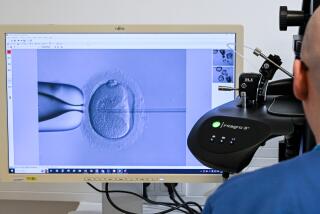Family Tragedies : Lawsuits Accuse Hospital of Suppressing Information on AIDS-Tainted Blood
- Share via
A decade after it was rocked by controversy when HIV contamination was found in some of its blood supply, Cedars-Sinai Medical Center faces more repercussions from the episode: The families of two infants who died of AIDS after receiving transfusions at the hospital have contended in lawsuits that the hospital deliberately withheld information about the tainted blood.
Both babies, Anique Kasper and Aaron Barbakow, were born prematurely in the early 1980s and were given HIV-tainted transfusions while in the center’s neonatal intensive-care unit. They subsequently died of AIDS, Aaron in February, 1991, at age 9 and Anique in July, 1992, at age 11. Jordan Barbakow, Aaron’s twin brother, also was given a transfusion at Cedars, but is healthy.
The families recently have filed separate lawsuits in Los Angeles Superior Court alleging that Cedars’ staff members knew of the probability that their children had received tainted transfusions several years before the families were notified in 1987, a claim the hospital denies.
The suits seek unspecified damages for emotional distress. The families say that if they had known earlier, they could have coped better with their children’s illnesses.
At the crux of both suits is when the hospital discovered the blood contamination.
The hospital has maintained that it did not learn about the tainted blood until it conducted a “look back study” in 1987, matching the contaminated blood through donor records with recipients, as other clinics and blood centers were doing at the time.
Dr. Thomas Mundy, a Cedars physician who directed the study in conjunction with the federal Centers for Disease Control in Atlanta, made his findings known in 1987 to the families with babies born at Cedars. Mundy found that 34 of about 700 babies born prematurely at the hospital received HIV-contaminated blood between 1980 and 1985.
At least 12 of those children have died since 1993, Mundy said, but an exact figure was not available. Cedars is treating 13, said hospital spokesman Ron Wise. A person can have the virus for eight to 11 years before getting full-blown AIDS, according to the Centers for Disease Control.
But Bruce Kasper, 53, of Playa del Rey, alleges the hospital was aware of contaminated blood before Mundy’s study. He points to a 1983 blood-product liability lawsuit filed against the hospital by the mother of a child who died of AIDS after receiving contaminated blood.
That suit, filed by Helen Kushnick, a former manager for “Tonight Show” host Jay Leno who lives in the San Fernando Valley, claimed the hospital was negligent in providing her son, Sam, with contaminated blood. But a judge dismissed the case on the ground that the hospital could not have known about the virus in the blood because no screening test had been developed yet. Such a test did not become available until 1985.
Kasper points to Helen Kushnick’s sworn statement in court papers in which she said a Cedars pathologist acknowledged the contaminated blood, but declined to disseminate the information.
“In October of 1983, my husband (Jerrold)and I met with Dr. Dennis Goldfinger . . . and a representative of Cedars’ Risk Management Department. My husband and I insisted at that time that Cedars contact parents of other children who were transfused while being treated at Cedars’ neonatal unit. Dr. Goldfinger stated that he did not wish to so inform other parents because such notification may have alarmed them unnecessarily,” Kushnick said in the statement.
Goldfinger’s lawyer, C. Snyder Patin, defended the doctor, saying Kasper’s “suit is completely groundless. There is no basis to it whatsoever. Fraudulent concealment is an absolute lie.”
Kasper’s and ex-wife Nicole Pascale’s suit, filed in March last year, is scheduled for trial later this year. A trial date for the suit by Dan and Beatrice Barbakow of Los Angeles, which was filed a few months ago, has not been set.
The hospital’s lawyers did not return phone calls seeking comment on either suit.
But in court papers filed with the Kasper suit, which is further along in the legal process, Cedars’ attorney Barbara Reardon defended the hospital, saying that Kasper has not presented any evidence of negligence or misconduct. And, Reardon contended, Kasper has not shown a date when anyone learned that Anique Kasper was transfused with HIV-tainted blood.
Hundreds have sued hospitals and blood banks because of tainted blood transfusions, but juries generally have ruled against the plaintiffs on the ground that hospitals either did not have a screening test available or used procedures accepted throughout the industry at the time.
Wilmer Harris, an attorney representing Kasper, sees those past cases as distinct from his. The other cases were based on the theory that the blood banks failed to use reasonable care in handling the blood and, as a result, some patients contracted AIDS. Harris’ case contends that once Cedars’ administrators became aware of the blood supply, they had a duty to inform the patients, even if those patients were no longer under their care.
To Kasper, his case is clear. “With the death of Sam Kushnick, the hospital had an obligation, a responsibility to look back at all the babies in the hospital.”
Dr. David Goldstein, the chief of internal medicine at the USC School of Medicine, agreed. In a deposition on behalf of Kasper filed a few weeks ago, he said that Cedars had an obligation to notify parents about the blood supply when they first learned of the possibility of contamination.
But Dr. Joseph Church, clinical director of the AIDS Center at Childrens Hospital in Los Angeles, said it’s difficult to locate people possibly contaminated with the HIV virus. His center treated Aaron Barbakow and Anique Kasper in the late 1980s.
“As far as I can tell, I don’t see fault anywhere,” said Church, who is expected to file a deposition on behalf of Cedars in the Kasper suit. “Look at the millions of people who received blood products from 1978 to 1985. With records, hospitals can find less than 20% (of patients), so anyone trying to reach patients had to use research and spend hundreds of thousands of dollars. By the time a record is three years or older, the information is non-traceable” because people move.
Dr. Shirley Fannin of the Los Angeles County Department of Health Services said there was no way of knowing about or preventing the tainted transfusions. “It was never my impression that anyone was concealing anything. It was public knowledge,” she said, recalling that she and the Kushnicks were interviewed extensively by the media in the early 1980s. Local and national media did stories on the Kushnick case.
“A hospital can only do so much” to find people who may be contaminated with the virus, Fannin said. “I find it hard to believe unless someone was off on Mars that they did not hear” about HIV blood contamination from clinics and hospitals.
Cedars attorneys have not commented on Barbakow’s suit, filed this year.
Barbakow, 45, said that if the hospital “could do it (notify them) in 1987, they could have done it earlier.”
“If someone’s life is in danger, doesn’t a hospital have an obligation to go back and track down patients and do all they can to help” even after they have stopped treatment there? Kasper asked.
In 1990, Cedars offered medical care to Anique Kasper after receiving numerous letters from Kasper. It offered AIDS-related medical care, however, only beyond what medical insurance would absorb. Bruce Kasper did not accept it and considered the limited offer a slap in the face from the facility where Anique contracted the virus. The same offer was extended to Dan Barbakow, who also declined.
Dan Barbakow and Bruce Kasper have the only current suits against Cedars, Harris said.
“Ultimately, the case will come down to whether Cedars-Sinai can put down a plausible case (explaining) why they did not tell anyone about the blood,” Harris said.
More to Read
Sign up for Essential California
The most important California stories and recommendations in your inbox every morning.
You may occasionally receive promotional content from the Los Angeles Times.










